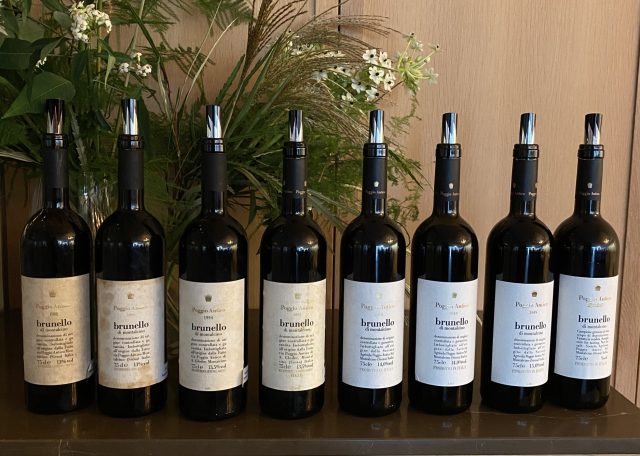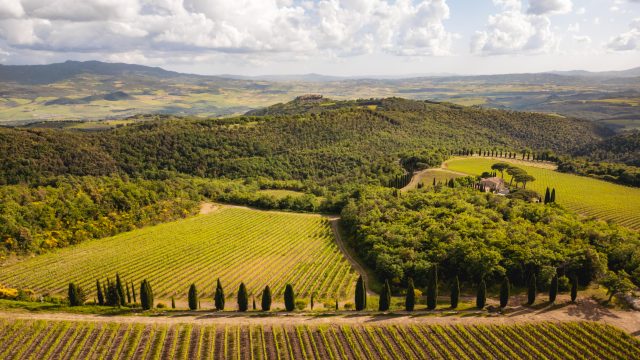This website uses cookies so that we can provide you with the best user experience possible. Cookie information is stored in your browser and performs functions such as recognising you when you return to our website and helping our team to understand which sections of the website you find most interesting and useful.
A study in Brunello: four decades of Poggio Antico
A recent vertical tasting of Poggio Antico’s flagship Brunello di Montalcino DOCG revealed how the high altitude Tuscan estate aims to showcase terroir over winemaking.

The tasting, which concerned a selection of vintages from 1988 to 2020, sought to shed light on what host and Italian wine expert Walter Speller called “quite an obscure estate”.
“You don’t hear a lot about Poggio Antico,” he said, “but to me it’s special because it consistently shows terroir-driven wines year after year. It’s a style of wine not set on fruit, but on minerality.”
The result of the union of I Poggio, Le Martine and Madre in 1976, Poggio Antico, situated south of the village of Montalcino, has grown into an estate with 38 hectares of vineyard (largely Sangiovese with a small amount of Cabernet Sauvignon and an even smaller amount of Chardonnay for non-commercial wines). The estate has been certified as organic since 2020.
In 2017, Poggio Antico was acquired by Belgian entrepreneur Marcel Van Poecke and his company Atlas Invest, and it has proved to be a wise investment.
“All the vineyards are around the estate, it’s quite a unique situation,” explained Speller. “Altitude was extremely important – vines planted at more than 500 metres above sea level – at the time no-one did that, there was very little viticulture at that highest part because they thought that Sangiovese would not ripen there, but in the next 30 years, with climate change, it will be vital.”
As for what those vines are grown on, general manager Pier Giuseppe D’Alessandro revealed: “When we studied the soils of Poggio Antico, we discovered 15 different kinds of soil. The geological definition is a chaotic complex, because these different soils are distributed in a chaotic way. We try to work with every unit of soil. Different soil means different vigour of the plant – it’s important to work in a tailor-made way.”
Each ‘unit’ of soil is vinified (in concrete) and aged (in Slavonia Oak botti) separately to maximise the options for blending. Earlier this year, Poggio Antico revealed that it would be constructing a new winery, as designed by architect Marco Casamonti.
To massively generalise, soil with a higher galestro (rocky, calcareous) content will retain heat and therefore produce wines with more ripeness, richness and power, whereas soil with more clay will produce softer, lighter ones. Winemaker Alessio Sostegni shared: “In a fresh vintage we will use more grapes from galestro, and in a drier vintage we will use more from clay.”

Another tool against the problems of a drier vintage is the 110R rootstock, which controls the vine’s vigour and helps its resistance to drought. Training techniques also play a part, with the agronomy team looking at replacing the guyot system with a form of alberello to control yields, and foster the growth of a healthy canopy, something which D’Alessandro dubbed “a new vine architecture to face climate change with”.
Though the vertical revealed a clear trend of increasing alcohol content, from around 13% ABV in 2020 to 15% and upwards in more recent vintages, sales and marketing manager Riccardo Bogi suggested that “we have to consider other parameters for alcohol change beyond climate change”, citing how vine planting density can change sugar concentration in the berries, though he acknowledges that the hot winds which hit the vineyards, partially a result of climate change, dry and concentrate the grapes, resulting in more alcohol.
Speller also argued that it is easy to become “obsessed” by ABVs, and that these wines should be viewed in the “correct context”, with them being consumed alongside food: “In the end, I look for balance.”
“A vintage assessment should be beginning to try and understand, rather than offering a verdict,” he argued.
2020 and 2019
“2020 can be considered one of the fresher vintages – frost cost us 40% of production,” said Sostegni. “We used more fruit from galestro soil – the clay soil was a tiny part because the clay soil during that vintage gave berries that weren’t good enough to give structure for Brunello, they were more for the Rosso.”
It was also revealed that in some vineyards where 4 to 5 tonnes per hectare might normally be harvested, yields had dropped to around one tonne per hectare.
Moving down to the vintage currently on the market, Sostegni shared: “In 2019 we produced around twice as much Brunello as in 2020. It was an amazing season – the right rainfall at the right time, the summer was not so hot, the ripening period was longer with fresh nights.”
The Consorzio del Vino Brunello di Montalcino rated 2019 as a five star vintage. However, from the 2020 vintage onwards, it will be abandoning the star-rating system.
2013, 2010 and 2001
Though the 2014 vintage, once maligned and now the subject of a critical reappraisal, was skipped, the year before that was similarly damp, according to Sostegni: “2013 was a wet harvest, we picked under the rain, like in 2024. The temperature was below the seasonal median. We did not have optical sorting, so we had 25 people sorting berries by hand. But with time, the wine has improved – it’s fresh, floral, not so fruity: we hope to have more ’13! The tannins aren’t green, even if the ripeness wasn’t perfect.”
“2010 is a bit outside the complex, it’s bigger,” said Speller. “I’m surprised at how much slower it develops than a lot of its peers.”
The acidity and the salinity of the 2010 seemed to jut out, and this writer feels that with food, especially red meat (perhaps wild boar, which are known to roam Poggio Antico’s vineyards), it would have been drinking better.
No such complaints could be made about the next vintage tasted. Berkmann Wine Cellars’ Alex Hunt MW dubbed the 2001: “The perfect example of reductive ageing.”
Of all the vintages tasted, the 2001 seemed to have been the one to receive the best reception, with its excellent concentration and ease of drinking.
1994, 1990 and 1988
Although the colour of the 1994 is certainly showing the wine’s 30 years of age, its fresh palate and aromas of balsamic and mushroom suggested that there’s still plenty of life left in it yet.
As for the 1990 and 1988, on the eye, on the nose, and on the palate it was clear that they were in their twilight years.
“I wasn’t even alive for these vintages,” revealed Sostegni. “But the consorzio said that ’88 and ’90 were really balanced vintages. When it went on the market, it was a really green wine – they were good ten years after they were released.”
Both 1988 and 1990 were rated as five stars by the consorzio.
But it’s no bad thing that these wines are drifting into being purely tertiary – after all, why would you buy a wine that old unless you wanted it taste like it?
However, with regards to the 1988, Speller said we should try tasting it “without thinking of its age”: “It’s not so distant from the 2019 or 2020.”
Scarlet thread
What links these eight vintages, with the first and the last separated by 32 years? Speller argued that the “red thread” which connects them all is that “the terroir eclipsed the winemaker”.
Speller’s own prediction is that climate change will make blends more important in Montalcino. Indeed, although Poggio Antico does have a single vineyard Brunello di Montalcino, Vigna i Poggi, made entirely of Sangiovese from I Poggi and launched with the 2019 vintage, Speller suggested that blending altitudes, as well as soil types, will help producers across the region to get a desirable level of ripeness.
Poggio Antico certainly has no intention of deviating from its focus on quality production.
“Poggio Antico does not bottle all its potential wine – we make around 100,000 bottles a year, but we have the potential to bottle almost double that,” said Sostegni. “What we think is not Poggio Antico quality, we sell to other wineries.”
Though D’Alessandro lamented that “extreme vintages are becoming the norm”, experiments with training methods and different blends are laying the groundwork to ensuring that this “quality” can be maintained in vintages yet to come – change is necessary to ensure that the “red thread” of terroir continues to be apparent.
As D’Alessandro succinctly put it: “The only element today that is the same as it was 100 years ago, and will be the same in the next century, is the soil.”
Related news
Glenfiddich becomes official partner of Aston Martin F1 team
Spain 'needs to learn how to market our fine wines', producer claims
Bourgogne wine see global growth despite difficult market conditions

